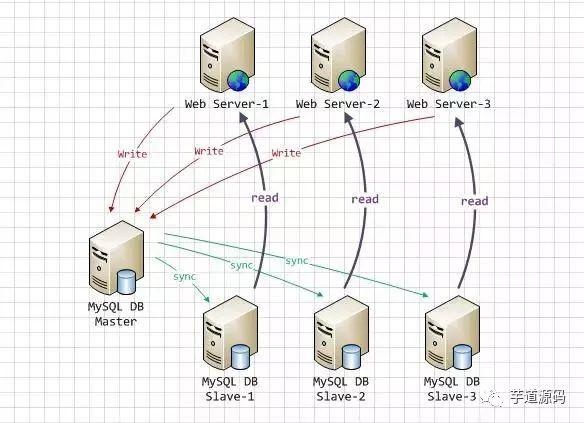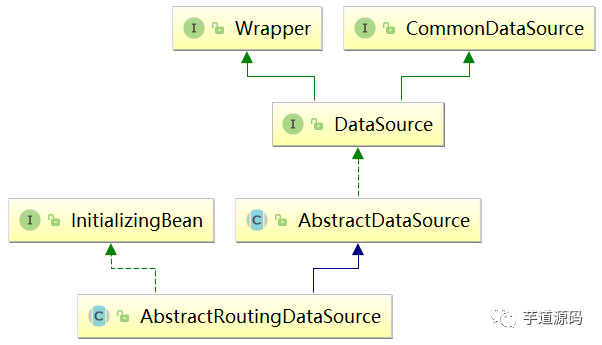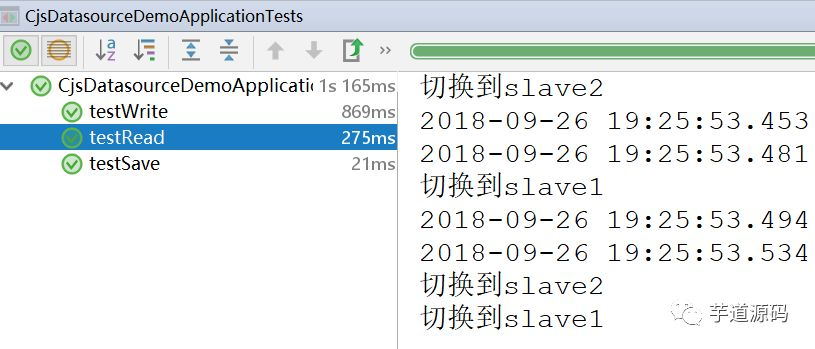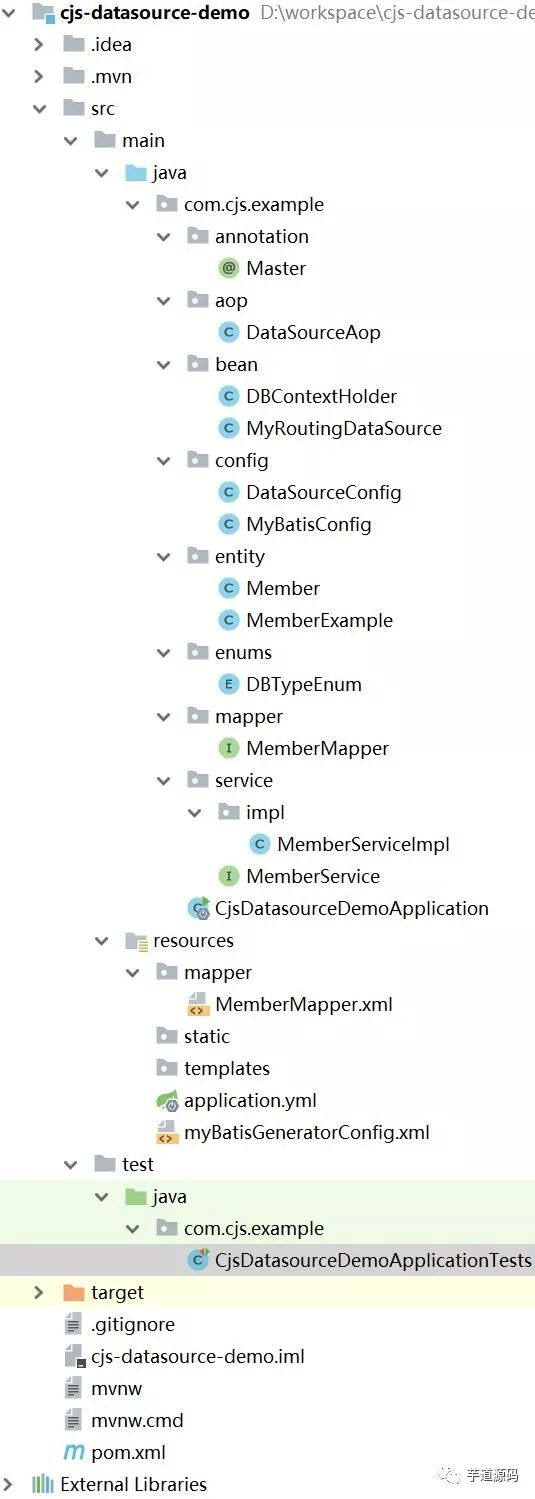SpringBoot + MyBatis + MySQL 读写分离实战
1. 引言
读写分离要做的事情就是对于一条SQL该选择哪个数据库去执行,至于谁来做选择数据库这件事儿,无非两个,要么中间件帮我们做,要么程序自己做。因此,一般来讲,读写分离有两种实现方式。第一种是依靠中间件(比如:MyCat),也就是说应用程序连接到中间件,中间件帮我们做SQL分离;第二种是应用程序自己去做分离。这里我们选择程序自己来做,主要是利用Spring提供的路由数据源,以及AOP。
然而,应用程序层面去做读写分离最大的弱点(不足之处)在于无法动态增加数据库节点,因为数据源配置都是写在配置中的,新增数据库意味着新加一个数据源,必然改配置,并重启应用。当然,好处就是相对简单。

2. AbstractRoutingDataSource
基于特定的查找key路由到特定的数据源。它内部维护了一组目标数据源,并且做了路由key与目标数据源之间的映射,提供基于key查找数据源的方法。

3. 实践
关于配置请参考:
https://www.cnblogs.com/cjsblog/p/9706370.html
3.1. maven依赖
<?xml version="1.0" encoding="UTF-8"?>
<project xmlns="http://maven.apache.org/POM/4.0.0" xmlns:xsi="http://www.w3.org/2001/XMLSchema-instance"
xsi:schemaLocation="http://maven.apache.org/POM/4.0.0 http://maven.apache.org/xsd/maven-4.0.0.xsd">
<modelVersion>4.0.0</modelVersion> <groupId>com.cjs.example</groupId>
<artifactId>cjs-datasource-demo</artifactId>
<version>0.0.1-SNAPSHOT</version>
<packaging>jar</packaging> <name>cjs-datasource-demo</name>
<description></description> <parent>
<groupId>org.springframework.boot</groupId>
<artifactId>spring-boot-starter-parent</artifactId>
<version>2.0.5.RELEASE</version>
<relativePath/> <!-- lookup parent from repository -->
</parent> <properties>
<project.build.sourceEncoding>UTF-8</project.build.sourceEncoding>
<project.reporting.outputEncoding>UTF-8</project.reporting.outputEncoding>
<java.version>1.8</java.version>
</properties> <dependencies>
<dependency>
<groupId>org.springframework.boot</groupId>
<artifactId>spring-boot-starter-aop</artifactId>
</dependency>
<dependency>
<groupId>org.springframework.boot</groupId>
<artifactId>spring-boot-starter-jdbc</artifactId>
</dependency>
<dependency>
<groupId>org.springframework.boot</groupId>
<artifactId>spring-boot-starter-web</artifactId>
</dependency>
<dependency>
<groupId>org.mybatis.spring.boot</groupId>
<artifactId>mybatis-spring-boot-starter</artifactId>
<version>1.3.2</version>
</dependency>
<dependency>
<groupId>org.apache.commons</groupId>
<artifactId>commons-lang3</artifactId>
<version>3.8</version>
</dependency> <dependency>
<groupId>mysql</groupId>
<artifactId>mysql-connector-java</artifactId>
<scope>runtime</scope>
</dependency>
<dependency>
<groupId>org.springframework.boot</groupId>
<artifactId>spring-boot-starter-test</artifactId>
<scope>test</scope>
</dependency>
</dependencies> <build>
<plugins>
<plugin>
<groupId>org.springframework.boot</groupId>
<artifactId>spring-boot-maven-plugin</artifactId>
</plugin> <!--<plugin>
<groupId>org.mybatis.generator</groupId>
<artifactId>mybatis-generator-maven-plugin</artifactId>
<version>1.3.5</version>
<dependencies>
<dependency>
<groupId>mysql</groupId>
<artifactId>mysql-connector-java</artifactId>
<version>5.1.46</version>
</dependency>
</dependencies>
<configuration>
<configurationFile>${basedir}/src/main/resources/myBatisGeneratorConfig.xml</configurationFile>
<overwrite>true</overwrite>
</configuration>
<executions>
<execution>
<id>Generate MyBatis Artifacts</id>
<goals>
<goal>generate</goal>
</goals>
</execution>
</executions>
</plugin>--> </plugins>
</build>
</project>
3.2. 数据源配置
application.yml
spring:
datasource:
master:
jdbc-url: jdbc:mysql://192.168.102.31:3306/test
username: root
password: 123456
driver-class-name: com.mysql.jdbc.Driver
slave1:
jdbc-url: jdbc:mysql://192.168.102.56:3306/test
username: pig # 只读账户
password: 123456
driver-class-name: com.mysql.jdbc.Driver
slave2:
jdbc-url: jdbc:mysql://192.168.102.36:3306/test
username: pig # 只读账户
password: 123456
driver-class-name: com.mysql.jdbc.Driver
多数据源配置
package com.cjs.example.config; import com.cjs.example.bean.MyRoutingDataSource;
import com.cjs.example.enums.DBTypeEnum;
import org.springframework.beans.factory.annotation.Qualifier;
import org.springframework.boot.context.properties.ConfigurationProperties;
import org.springframework.boot.jdbc.DataSourceBuilder;
import org.springframework.context.annotation.Bean;
import org.springframework.context.annotation.Configuration; import javax.sql.DataSource;
import java.util.HashMap;
import java.util.Map; /**
* 关于数据源配置,参考SpringBoot官方文档第79章《Data Access》
* 79. Data Access
* 79.1 Configure a Custom DataSource
* 79.2 Configure Two DataSources
*/ @Configuration
public class DataSourceConfig { @Bean
@ConfigurationProperties("spring.datasource.master")
public DataSource masterDataSource() {
return DataSourceBuilder.create().build();
} @Bean
@ConfigurationProperties("spring.datasource.slave1")
public DataSource slave1DataSource() {
return DataSourceBuilder.create().build();
} @Bean
@ConfigurationProperties("spring.datasource.slave2")
public DataSource slave2DataSource() {
return DataSourceBuilder.create().build();
} @Bean
public DataSource myRoutingDataSource(@Qualifier("masterDataSource") DataSource masterDataSource,
@Qualifier("slave1DataSource") DataSource slave1DataSource,
@Qualifier("slave2DataSource") DataSource slave2DataSource) {
Map<Object, Object> targetDataSources = new HashMap<>();
targetDataSources.put(DBTypeEnum.MASTER, masterDataSource);
targetDataSources.put(DBTypeEnum.SLAVE1, slave1DataSource);
targetDataSources.put(DBTypeEnum.SLAVE2, slave2DataSource);
MyRoutingDataSource myRoutingDataSource = new MyRoutingDataSource();
myRoutingDataSource.setDefaultTargetDataSource(masterDataSource);
myRoutingDataSource.setTargetDataSources(targetDataSources);
return myRoutingDataSource;
} }
这里,我们配置了4个数据源,1个master,2两个slave,1个路由数据源。前3个数据源都是为了生成第4个数据源,而且后续我们只用这最后一个路由数据源。
MyBatis配置
package com.cjs.example.config; import org.apache.ibatis.session.SqlSessionFactory;
import org.mybatis.spring.SqlSessionFactoryBean;
import org.springframework.context.annotation.Bean;
import org.springframework.context.annotation.Configuration;
import org.springframework.core.io.support.PathMatchingResourcePatternResolver;
import org.springframework.jdbc.datasource.DataSourceTransactionManager;
import org.springframework.transaction.PlatformTransactionManager;
import org.springframework.transaction.annotation.EnableTransactionManagement; import javax.annotation.Resource;
import javax.sql.DataSource; @EnableTransactionManagement
@Configuration
public class MyBatisConfig { @Resource(name = "myRoutingDataSource")
private DataSource myRoutingDataSource; @Bean
public SqlSessionFactory sqlSessionFactory() throws Exception {
SqlSessionFactoryBean sqlSessionFactoryBean = new SqlSessionFactoryBean();
sqlSessionFactoryBean.setDataSource(myRoutingDataSource);
sqlSessionFactoryBean.setMapperLocations(new PathMatchingResourcePatternResolver().getResources("classpath:mapper/*.xml"));
return sqlSessionFactoryBean.getObject();
} @Bean
public PlatformTransactionManager platformTransactionManager() {
return new DataSourceTransactionManager(myRoutingDataSource);
}
}
由于Spring容器中现在有4个数据源,所以我们需要为事务管理器和MyBatis手动指定一个明确的数据源。
3.3. 设置路由key / 查找数据源
目标数据源就是那前3个这个我们是知道的,但是使用的时候是如果查找数据源的呢?
首先,我们定义一个枚举来代表这三个数据源
package com.cjs.example.enums;
public enum DBTypeEnum {
MASTER, SLAVE1, SLAVE2;
}
接下来,通过ThreadLocal将数据源设置到每个线程上下文中
package com.cjs.example.bean;
import com.cjs.example.enums.DBTypeEnum;
import java.util.concurrent.atomic.AtomicInteger;
public class DBContextHolder {
private static final ThreadLocal<DBTypeEnum> contextHolder = new ThreadLocal<>();
private static final AtomicInteger counter = new AtomicInteger(-1);
public static void set(DBTypeEnum dbType) {
contextHolder.set(dbType);
}
public static DBTypeEnum get() {
return contextHolder.get();
}
public static void master() {
set(DBTypeEnum.MASTER);
System.out.println("切换到master");
}
public static void slave() {
// 轮询
int index = counter.getAndIncrement() % 2;
if (counter.get() > 9999) {
counter.set(-1);
}
if (index == 0) {
set(DBTypeEnum.SLAVE1);
System.out.println("切换到slave1");
}else {
set(DBTypeEnum.SLAVE2);
System.out.println("切换到slave2");
}
}
}
获取路由key
package com.cjs.example.bean; import org.springframework.jdbc.datasource.lookup.AbstractRoutingDataSource;
import org.springframework.lang.Nullable; public class MyRoutingDataSource extends AbstractRoutingDataSource {
@Nullable
@Override
protected Object determineCurrentLookupKey() {
return DBContextHolder.get();
} }
设置路由key
默认情况下,所有的查询都走从库,插入/修改/删除走主库。我们通过方法名来区分操作类型(CRUD)
package com.cjs.example.aop; import com.cjs.example.bean.DBContextHolder;
import org.apache.commons.lang3.StringUtils;
import org.aspectj.lang.JoinPoint;
import org.aspectj.lang.annotation.Aspect;
import org.aspectj.lang.annotation.Before;
import org.aspectj.lang.annotation.Pointcut;
import org.springframework.stereotype.Component; @Aspect
@Component
public class DataSourceAop { @Pointcut("!@annotation(com.cjs.example.annotation.Master) " +
"&& (execution(* com.cjs.example.service..*.select*(..)) " +
"|| execution(* com.cjs.example.service..*.get*(..)))")
public void readPointcut() { } @Pointcut("@annotation(com.cjs.example.annotation.Master) " +
"|| execution(* com.cjs.example.service..*.insert*(..)) " +
"|| execution(* com.cjs.example.service..*.add*(..)) " +
"|| execution(* com.cjs.example.service..*.update*(..)) " +
"|| execution(* com.cjs.example.service..*.edit*(..)) " +
"|| execution(* com.cjs.example.service..*.delete*(..)) " +
"|| execution(* com.cjs.example.service..*.remove*(..))")
public void writePointcut() { } @Before("readPointcut()")
public void read() {
DBContextHolder.slave();
} @Before("writePointcut()")
public void write() {
DBContextHolder.master();
} /**
* 另一种写法:if...else... 判断哪些需要读从数据库,其余的走主数据库
*/
// @Before("execution(* com.cjs.example.service.impl.*.*(..))")
// public void before(JoinPoint jp) {
// String methodName = jp.getSignature().getName();
//
// if (StringUtils.startsWithAny(methodName, "get", "select", "find")) {
// DBContextHolder.slave();
// }else {
// DBContextHolder.master();
// }
// }
}
有一般情况就有特殊情况,特殊情况是某些情况下我们需要强制读主库,针对这种情况,我们定义一个主键,用该注解标注的就读主库
package com.cjs.example.annotation;
public @interface Master {
}
例如,假设我们有一张表member
package com.cjs.example.service.impl;
import com.cjs.example.annotation.Master;
import com.cjs.example.entity.Member;
import com.cjs.example.entity.MemberExample;
import com.cjs.example.mapper.MemberMapper;
import com.cjs.example.service.MemberService;
import org.springframework.beans.factory.annotation.Autowired;
import org.springframework.stereotype.Service;
import org.springframework.transaction.annotation.Transactional;
import java.util.List;
@Service
public class MemberServiceImpl implements MemberService {
@Autowired
private MemberMapper memberMapper;
@Transactional
@Override
public int insert(Member member) {
return memberMapper.insert(member);
}
@Master
@Override
public int save(Member member) {
return memberMapper.insert(member);
}
@Override
public List<Member> selectAll() {
return memberMapper.selectByExample(new MemberExample());
}
@Master
@Override
public String getToken(String appId) {
// 有些读操作必须读主数据库
// 比如,获取微信access_token,因为高峰时期主从同步可能延迟
// 这种情况下就必须强制从主数据读
return null;
}
}
4. 测试
package com.cjs.example; import com.cjs.example.entity.Member;
import com.cjs.example.service.MemberService;
import org.junit.Test;
import org.junit.runner.RunWith;
import org.springframework.beans.factory.annotation.Autowired;
import org.springframework.boot.test.context.SpringBootTest;
import org.springframework.test.context.junit4.SpringRunner; @RunWith(SpringRunner.class)
@SpringBootTest
public class CjsDatasourceDemoApplicationTests { @Autowired
private MemberService memberService; @Test
public void testWrite() {
Member member = new Member();
member.setName("zhangsan");
memberService.insert(member);
} @Test
public void testRead() {
for (int i = 0; i < 4; i++) {
memberService.selectAll();
}
} @Test
public void testSave() {
Member member = new Member();
member.setName("wangwu");
memberService.save(member);
} @Test
public void testReadFromMaster() {
memberService.getToken("1234");
} }
查看控制台


5. 工程结构

SpringBoot + MyBatis + MySQL 读写分离实战的更多相关文章
- SpringBoot+MyBatis+MySQL读写分离
1. 引言 读写分离要做的事情就是对于一条SQL该选择哪个数据库去执行,至于谁来做选择数据库这件事儿,无非两个,要么中间件帮我们做,要么程序自己做.因此,一般来讲,读写分离有两种实现方式.第一种是依 ...
- SpringBoot+MyBatis+MySQL读写分离(实例)
1. 引言 读写分离要做的事情就是对于一条SQL该选择哪个数据库去执行,至于谁来做选择数据库这件事儿,无非两个,要么中间件帮我们做,要么程序自己做.因此,一般来讲,读写分离有两种实现方式.第一种是 ...
- 构建高性能web之路------mysql读写分离实战(转)
一个完整的mysql读写分离环境包括以下几个部分: 应用程序client database proxy database集群 在本次实战中,应用程序client基于c3p0连接后端的database ...
- mysql读写分离实战
一个完整的MySQL读写分离环境包括以下几个部分: 应用程序client database proxy database集群 在本次实战中,应用程序client基于c3p0连接后端的database ...
- Spring Boot+MyBatis+MySQL读写分离
读写分离要做的事情就是对于一条sql语句该选择去哪个数据库执行,至于谁来做选择数据库的事情,无非两个,1:中间件(比如MyCat):二:程序自己去做分离操作. 但是从程序成眠去做读写分离最大的弱点就是 ...
- 构建高性能web之路------mysql读写分离实战
http://blog.csdn.net/cutesource/article/details/5710645 http://www.jb51.net/article/38953.htm http:/ ...
- spring MVC、mybatis配置读写分离
spring MVC.mybatis配置读写分离 1.环境: 3台数据库机器,一个master,二台slave,分别为slave1,slave2 2.要实现的目标: ①使数据写入到master ②读数 ...
- Amoeba-mysql读写分离实战
Amoeba-mysql读写分离实战 Amoeba用途有很多,这里看标题我们就先说读写分离,因为我也只会这个.Amoeba定义为国内的,开源的.目前(2015年10月20日)我们用amoeba2.2版 ...
- ProxySQL实现Mysql读写分离 - 部署手册
ProxySQL是一个高性能的MySQL中间件,拥有强大的规则引擎.ProxySQL是用C++语言开发的,也是percona推的一款中间件,虽然也是一个轻量级产品,但性能很好(据测试,能处理千亿级的数 ...
随机推荐
- Java实现 LeetCode 513 找树左下角的值
513. 找树左下角的值 给定一个二叉树,在树的最后一行找到最左边的值. 示例 1: 输入: 2 / \ 1 3 输出: 1 示例 2: 输入: 1 / \ 2 3 / / \ 4 5 6 / 7 输 ...
- Java实现莱布尼兹问题
历史上有许多计算圆周率pai的公式,其中,格雷戈里和莱布尼茨发现了下面的公式: pai = 4*(1-1/3+1/5-1/7 -) 参见[图1.png] 这个公式简单而优美,但美中不足,它收敛的太慢了 ...
- Java实现字符串的包含
1 问题描述 给定一长字符串A和一短字符串B.请问,如何最快地判断出短字符串B中的所有字符是否都在长字符串A中?请编写一个判断函数实现此功能. 为简单起见,假设输入的字符串只包含小写英文字母.下面举几 ...
- Jmeter让压测随时做起来(转载)
为什么要压测 这个问题问的其实挺没有必要的,做开发的同学应该都很清楚,压测的必要性,压力测试主要目的就是让我们在上线前能够了解到我们系统的承载能力,和当前.未来系统压力的提升情况,能够评估出当前系统的 ...
- Maven发布Release到中心仓库历程记录(无个人域名)
Maven发布Release到中心仓库历程记录(无个人域名) 前言 因为前段时间自己做了一个爬虫项目(地址),自己很希望分享到maven中心仓库上,感觉拥有自己的jar包令我兴奋,便开始了maven发 ...
- Node.js躬行记(3)——命令行工具
一.自定义 创建一个空目录,然后通过npm init命令初始化package.json文件,并按提示输入相关信息或直接回车使用默认信息,生成的内容如下所示. { "name": & ...
- Netty 中的内存分配浅析
Netty 出发点作为一款高性能的 RPC 框架必然涉及到频繁的内存分配销毁操作,如果是在堆上分配内存空间将会触发频繁的GC,JDK 在1.4之后提供的 NIO 也已经提供了直接直接分配堆外内存空间的 ...
- @codefoces - 566E@ Restoring Map
目录 @description@ @solution@ @accepted code@ @details@ @description@ 对于一棵 n 个点的树,我们称两个点是相邻的当且仅当两个点的距离 ...
- idea同时选中多个相同的内容并编辑
原文链接: 首先选中你需要编辑的内容,然后Ctrl+R屏幕上会出现如下的操作栏 第一个框是查询并选中所有相同的内容第二个框是输入你要修改的内容,最后点击Replace all,就可以把所有内容替换.
- Python按顺序读取文件夹中文件
参考资料: https://blog.csdn.net/qq_22227123/article/details/79903116 https://blog.csdn.net/merdy_xi/arti ...
